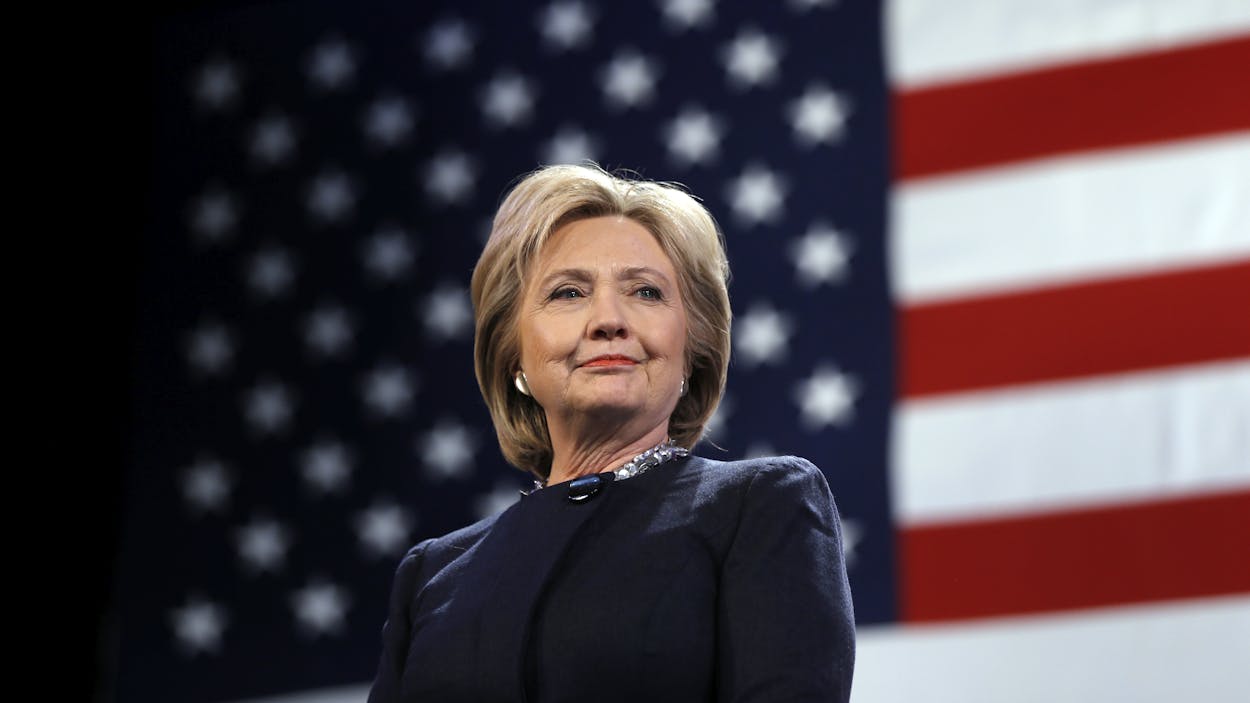Over the weekend, New York magazine published Rebecca Traister’s profile of Hillary Clinton—an in-depth look at the candidate widely expected to be the Democratic presidential nominee this year. The piece also contains an exchange of particular interest to those hoping to keep Texas from turning orange in November:
I asked her whether the time she was spending in Kentucky, a red state, reflected more than her desire to win the primary there the following week (which she did, by a hair). Her eyes lit up; it’s as if she’d been waiting for someone to ask her about the surprising possibilities of the electoral map this year. So which states do you think Trump puts in play? I asked, mentioning the possibility of Georgia, which some think could go Democratic for the first time since her husband won it in 1992.
“Texas!” she exclaimed, eyes wide, as if daring me to question this, which I did. “You are not going to win Texas,” I said. She smiled, undaunted. “If black and Latino voters come out and vote, we could win Texas,” she told me firmly, practically licking her lips.
Traister’s skepticism is well-founded for reasons that any Texan can quickly reel off: the Republican candidate has won the state’s electoral votes in every presidential election since 1980; Democrats have not won any statewide executive offices since 1994; in 2014, despite the fact that national Democrats felt comparatively punchy about the prospect of the state soon “turning blue,” Republicans swept the top-of-the-ticket races by a roughly 20-point margin, and so on, and so forth.
Even so I commend Clinton’s ethos here. The fact that she refuses to preemptively declare defeat makes it clear enough that she’s not a Texas Democrat. Still, she is surprisingly well-regarded among Democrats in the state, and she’s heading into a presidential election against a Republican nominee who is anomalously weak among Texas Republicans and a newly minted Libertarian Party nominee—former New Mexico Governor Gary Johnson—whose presence on the ballot provides an alternative for conservatives who can’t stomach the idea of voting for either of the major-party candidates.
In view of all of that I, for one, think Clinton has a chance of winning Texas this year for reasons that I detailed last month. I’ll just add a disclaimer here, for emphasis: in light of empirical evidence from polling and recent elections, it’s obvious that Clinton’s path to victory in Texas wouldn’t be easy. It’s important to take the empirical evidence seriously in such cases.
At the same time, the empirical evidence obviously has to include an asterisk this time around, because if past elections were perfectly predictive of voter behavior in 2016, Trump wouldn’t be the Republican nominee. Clearly, some longstanding assumptions about the American electorate have been called into question, if not outright subverted. And though there’s no way to predict how widespread the Republican disaffection will be come November—at this stage, at least—it’s clear that it exists in the state specifically. The most influential conservative in Texas, at the moment, is Ted Cruz, and he is among the handful of national Republican leaders who have conspicuously declined to endorse neither Trump or Clinton.
It seems that empirical evidence on campaigning in Texas deserves an asterisk too, because Clinton has now declared her intention to do something no Democrat has attempted recently: compete in a general election in Texas with the goal of winning. Barack Obama didn’t allocate serious time or resources to try to win the state’s electoral votes in 2008 or 2012. Neither, I would argue, did Wendy Davis in 2014 gubernatorial campaign. It may be true, as Jim Henson and Joshua Blank write, that both of those candidates started the general election season with a similar baseline of support as Clinton will now; all the same, this general election season may unfold differently than the previous ones.
If polling circa October shows that Clinton is cruising towards a 40-state landslide victory—or, conversely, that the whole election is likely to hinge on a couple of exurbs in Pennsylvania—she might not have a clear incentive to compete in Texas. As it stands, though, I’d say there’s no harm in Clinton trying to win Texas’s votes, and there are plenty of potential upsides for her and her party. At the very best, from her perspective, she wins. Failing that, she could help the beleaguered Texas Democrats build their party infrastructure and pick up a few more seats in the Texas Legislature. At the very least, she might compel Trump to spend time and money in a state he was hoping to neglect; if so, that would also mean that Clinton has a chance to troll Texas Republicans by forcing them to appear with Trump at the occasional in-state appearance.
And personally, I’m happy to hear that Clinton wants to give it a try, because if there’s anything I’ve learned from Sid Miller, or Ken Paxton, or Dan Patrick’s press conference on Fort Worth ISD bathrooms earlier today, it’s that neither of the major political parties is putting on a particularly impressive performance in Texas lately. Ideally, both would. So we should all consider the long-term merits of either team’s stated strategic goals: Republicans want to keep Texas red. Democrats want to turn it blue. A better alternative, for both, may be to turn Texas purple.







